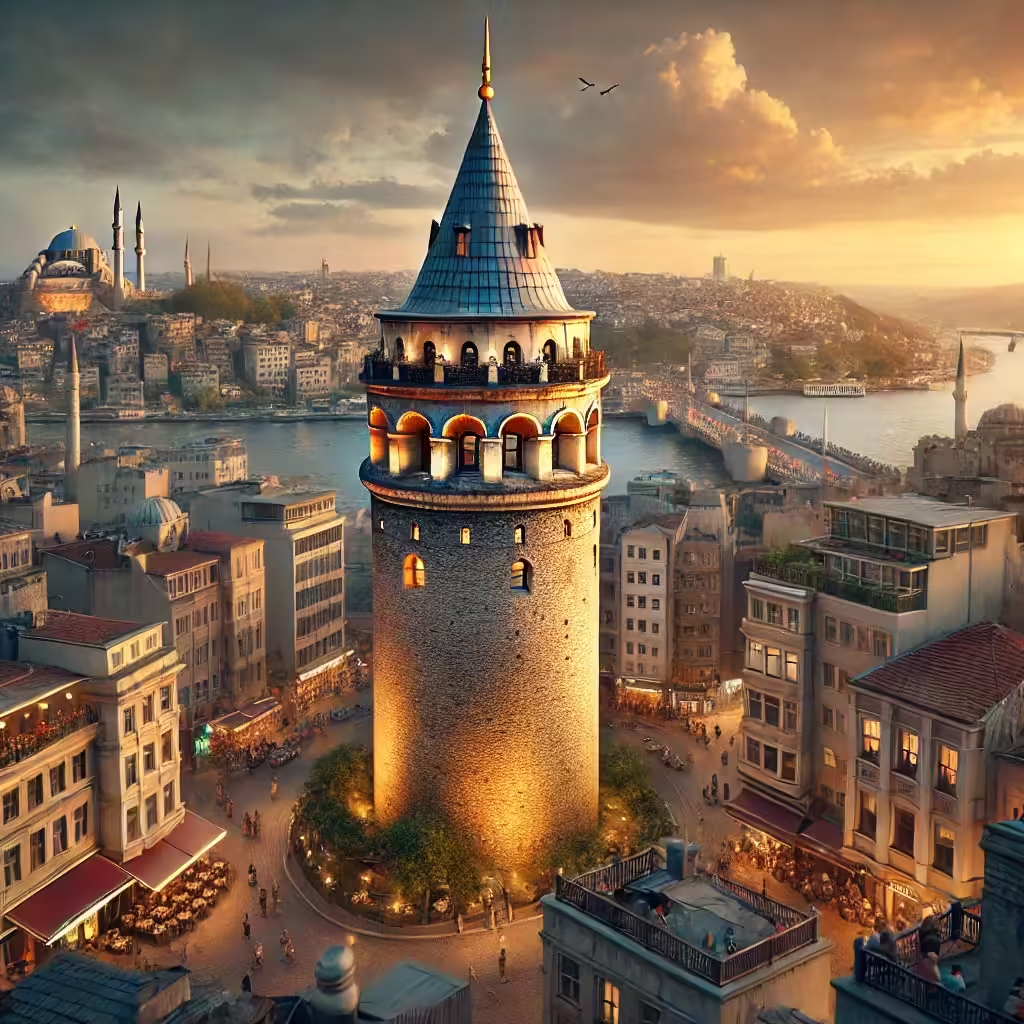Galata Tower – The Timeless Guardian of Istanbul / Galata Kulesi – İstanbul’un Zamansız Muhafızı
1.Introduction to Galata Tower / Galata Kulesi’ne Giriş
English Version
Galata Tower, standing 63 meters tall, is one of the most famous historical landmarks in Istanbul, Turkey.This medieval stone tower dominates the skyline of Galata, offering a 360-degree panoramic view of the Bosphorus, Golden Horn, and the historic peninsula.
Originally built in 1348 by the Genoese, the tower was part of the fortifications of Galata, a Genoese trading colony in Constantinople.Over the centuries, Galata Tower played multiple roles, including a watchtower, fire observatory, and even an aviation experiment site by the Ottoman scientist Hezarfen Ahmed Çelebi.
Today, Galata Tower serves as a museum and observation deck, attracting millions of tourists every year.With its rich history, architectural beauty, and breathtaking views, it remains a symbol of Istanbul’s resilience and grandeur.
Türkçe Çeviri
63 metre yüksekliğindeki Galata Kulesi, İstanbul’un en ünlü tarihi simgelerinden biridir.Galata semtinin siluetine hâkim olan bu ortaçağ taş kulesi, Boğaz, Haliç ve tarihi yarımada üzerinde 360 derece panoramik bir manzara sunmaktadır.
1348 yılında Cenevizliler tarafından inşa edilen kule, Ceneviz kolonisinin surlarını tamamlamak için yapılan bir tahkimatın parçasıydı.Yüzyıllar boyunca Galata Kulesi farklı amaçlar için kullanılmış, gözetleme noktası, yangın kulesi ve hatta Osmanlı bilim insanı Hezarfen Ahmed Çelebi’nin uçuş deneyi yaptığı yer olmuştur.
Günümüzde, Galata Kulesi bir müze ve gözlem terası olarak hizmet vermektedir ve her yıl milyonlarca turisti ağırlamaktadır.Zengin tarihi, mimari güzelliği ve büyüleyici manzarası ile İstanbul’un zamansız sembollerinden biri olmaya devam etmektedir.
2.The History of Galata Tower / Galata Kulesi’nin Tarihi
English Version
Galata Tower has a long and fascinating history, marked by Byzantine, Genoese, and Ottoman influences:
✔ Byzantine Period (6th Century AD): The first watchtower on this site was built during the reign of Emperor Justinian (528 AD), but it was later destroyed during conflicts.
✔ Genoese Construction (1348): The current structure was built by the Genoese Republic, forming part of the defensive walls of their Galata trade colony.The tower was originally named the “Christea Turris” (Tower of Christ).
✔ Ottoman Conquest (1453): After Mehmed II (Fatih Sultan Mehmet) conquered Constantinople, the tower was used as a prison, a fire lookout tower, and a military watchtower.
✔ Hezarfen Ahmed Çelebi’s Flight (17th Century): The famous Ottoman scientist Hezarfen Ahmed Çelebi reportedly used wooden wings to glide from the top of Galata Tower across the Bosphorus to Üsküdar.
✔ 19th Century Fire Watchtower: During the Ottoman period, Galata Tower played a crucial role as a fire lookout post, as many parts of the city were made of wood.
✔ Modern Restorations (20th-21st Century): The tower underwent multiple restorations, with the most recent in 2020, transforming it into a modern museum with interactive exhibits.
Türkçe Çeviri
Galata Kulesi, Bizans, Ceneviz ve Osmanlı izleri taşıyan uzun ve büyüleyici bir tarihe sahiptir:
✔ Bizans Dönemi (6.Yüzyıl): İmparator I.Justinianus (MS 528) döneminde burada bir gözetleme kulesi inşa edilmiştir, ancak zamanla savaşlar sırasında yıkılmıştır.
✔ Ceneviz İnşası (1348): Günümüzdeki kule, Ceneviz Cumhuriyeti tarafından inşa edilmiş ve Galata kolonisini savunmak için surların bir parçası olarak kullanılmıştır.Orijinal adı “Christea Turris” (İsa Kulesi) olarak bilinmektedir.
✔ Osmanlı Fethi (1453): Fatih Sultan Mehmet’in İstanbul’u fethetmesinden sonra, kule hapishane, yangın gözetleme noktası ve askeri gözetleme kulesi olarak kullanılmıştır.
✔ Hezarfen Ahmed Çelebi’nin Uçuşu (17.Yüzyıl): Osmanlı bilim insanı Hezarfen Ahmed Çelebi, kanatlar takarak Galata Kulesi’nden Üsküdar’a uçtuğu efsanesiyle tanınmaktadır.
✔ 19.Yüzyıl Yangın Gözetleme Kulesi: Osmanlı döneminde şehirde sık sık çıkan yangınları önlemek amacıyla kule bir yangın gözetleme noktası olarak kullanılmaya başlanmıştır.
✔ Modern Restorasyonlar (20.-21.Yüzyıl): Kule, birçok kez restore edilmiştir ve son olarak 2020 yılında kapsamlı bir yenileme geçirmiş, müze ve interaktif sergilerle modern bir turistik merkez haline gelmiştir.
3.Architectural Features of Galata Tower / Galata Kulesi’nin Mimari Özellikleri
English Version
✔ Medieval Stone Structure: The tower is built using limestone, granite, and brick, making it highly durable.
✔ Cylindrical Form: The tower has a circular shape with 3.75m-thick walls at the base, narrowing towards the top.
✔ Nine Floors: The tower consists of nine levels, including a panoramic viewing terrace.
✔ Conical Roof: The Ottoman-era cone-shaped roof gives the tower its distinctive silhouette.
✔ Spiral Staircase & Elevator: Visitors can either climb the 146 steps or use the modern elevator to reach the observation deck.
Türkçe Çeviri
✔ Ortaçağ Taş Yapı: Kireç taşı, granit ve tuğladan inşa edilen kule, son derece sağlamdır.
✔ Silindirik Form: Temelinde 3,75 metre kalınlığında duvarları olan kule, yukarı doğru daralmaktadır.
✔ Dokuz Katlı Yapı: Kule toplam dokuz kata sahiptir ve en üst katı panoramik seyir terasıdır.
✔ Konik Çatı: Osmanlı döneminde eklenen konik çatı, kuleye karakteristik görünümünü kazandırmıştır.
✔ Sarmal Merdiven ve Asansör: 146 basamaklı taş merdivenleri çıkabilir veya modern asansörü kullanarak zirveye ulaşabilirsiniz.
4.Visitor Information / Ziyaret Bilgileri
- Location: Galata, Beyoğlu, Istanbul, Turkey
- Opening Hours: Open daily (09:00 – 22:00)
- Entrance Fee: Paid entry (discount for locals)
- Best Time to Visit: Sunset for stunning views
📌 Galata Tower is an unforgettable landmark that blends history, myths, and breathtaking views of Istanbul.
🚀 If you want to experience one of Istanbul’s most famous viewpoints, visiting Galata Tower is a must!
📌 Galata Kulesi, efsaneler ve tarih ile çevrili, İstanbul’un en etkileyici yapılarından biridir.
🚀 İstanbul’un en ünlü seyir noktalarından birinde eşsiz bir deneyim yaşamak istiyorsanız, Galata Kulesi’ni mutlaka ziyaret edin!

